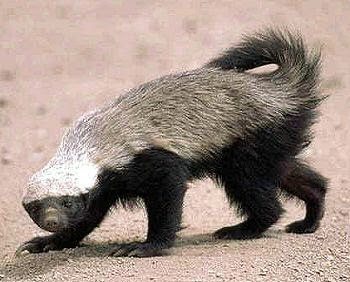
The honey badger is native to Africa and parts of the Middle East. It is considered the most fearless animal in the world by the Guinness Book of World Records.
According to wikipedia:
"The honey badger is found in arid grasslands and savannahs. Honey badgers are fierce carnivores with a keen sense of smell. They are known for their snake-killing abilities; they use their jaws to grab a snake behind its head and kill it. Honey badgers can devour a snake (150 cm/5ft or less) in 15 minutes.
Badgers have a large appetite for beehives. Commercial honey producers do not take kindly to this destruction and sometimes shoot, trap or poison badgers they suspect of damaging their hives, although badger-proof commercial bee hives have been developed.
The badger is among the fiercest hunters in its range, with prey including earthworms, insects, scorpions, porcupines, hares, ground squirrels, meerkats, mongooses and larger prey such as tortoises, crocodiles up to one metre in size, young gazelle and snakes (including pythons and venomous species). They also take lizards, frogs small rodents, birds and fruit.
The badger's ferocious reputation reflects its tendency to attack animals larger than itself; it is seldom preyed upon...
In a recent study (2009) undertaken by the magazine Scientific American it has been found that pound for pound the honey badger is the world's most fearsome land mammal as a result of its favourable claw to body ratio and aggressive behavioural tendencies...
It was also mentioned by Jeremy Clarkson on BBC Top Gear's Botswana Special that 'A Honey Badger does not kill you to eat you. It tears off your testicles.'"
I guess we need not worry about too much about whether this creature will be able to survive in the wild. As Robert pointed out, it appears the only real danger to him in W-S is cars.

7 comments:
A honey badger makes the raccoon I saw in our backyard seem tame in comparison.
Though, ironically, this particular honey badger presumably is tame, at least in comparison to your (wild) raccoon. Or at least I hope W/S doesn't have a here-to-fore unnoticed population of feral honey badgers.
Clarkson's statement, btw, is a reference to the honey badger's defensive fighting style against larger predators- it rears up on its hind legs and claws with its huge foreclaws. The honey badger being about 3' tall in that orientation, said claws tend to encounter the average male human at an unfortunate height.
Rvman, we can always do a little tameness test - make him mad and see if he goes for your 'nads. (But he better not be bothering those bunnies!)
Mom, I liked that we used to see raccoons at our apartment complex in Austin.
Sweet!
http://www.tvloop.com/top-gear/show/quotes/james-may-james-rhymes-off-lots-of-dangerous-219485
Nice, this guy is now officially the Badger of Death.
Thanks for the info, Rick.
Andrew Sullivan just posted a link to this terrifying honey badger video.
Post a Comment